Research
Auroral Kilometric Radiation I: Source locations determined by Cluster VLBI Array Observations We
used the Cluster Wideband Data instrument to determine the locations of
auroral kilometric radiation (AKR) using very long baseline
interferometry. The technique involves cross-correlating individual AKR
bursts from all six Cluster baselines using time and frequency filtered
waveforms. The resulting differential delay peaks are used to determine
source locations with an uncertainty as small as 500 km in a plane
perpendicular to the source-spacecraft line of sight or about 200 km
when the burst position is projected onto the auroral zone along the
magnetic field lines passing through the source. The uncertainty along
the line of sight is much larger, but this is mitigated by assuming
that the emission arises from a height corresponding to the electron
gyrofrequency. We report the locations of over 1700 individual AKR
bursts during six observing epochs between 10 July 2002 and 22 January
2003 when the Cluster constellation was high above the Southern or
Northern Hemisphere. In general we find that the AKR burst locations
lie along magnetic field lines which map onto the nighttime auroral
zone as expected from previous AKR studies. For the three observing
epochs viewing the Northern Hemisphere, there is a strong tendency for
AKR burst locations to be centered within the auroral oval and in the
evening sector. The Southern Hemisphere burst locations favor magnetic
local midnight to early morning and have somewhat higher invariant
magnetic latitudes. The distribution of AKR auroral footprint locations
at each epoch had a overall spatial scale between 1000 and 2000 km,
much larger than the positional uncertainty of an individual AKR burst
location magnetic footprint, but a small fraction of the auroral oval.
This indicates that on a timescale of 1-3 hours conditions for suitable
generation of AKR emission are found on only a fraction of all magnetic
field lines crossing through the auroral oval. For two of the six
epochs, there was a significant drift in the mean location of AKR
activity over a period of 1-2 hours. The drift was predominantly in
latitude at one epoch and in longitude at the other, with average drift
speed V ~ 80-90 m s-1 at the AKR emission location. We
used the Cluster Wideband Data instrument to determine the locations of
auroral kilometric radiation (AKR) using very long baseline
interferometry. The technique involves cross-correlating individual AKR
bursts from all six Cluster baselines using time and frequency filtered
waveforms. The resulting differential delay peaks are used to determine
source locations with an uncertainty as small as 500 km in a plane
perpendicular to the source-spacecraft line of sight or about 200 km
when the burst position is projected onto the auroral zone along the
magnetic field lines passing through the source. The uncertainty along
the line of sight is much larger, but this is mitigated by assuming
that the emission arises from a height corresponding to the electron
gyrofrequency. We report the locations of over 1700 individual AKR
bursts during six observing epochs between 10 July 2002 and 22 January
2003 when the Cluster constellation was high above the Southern or
Northern Hemisphere. In general we find that the AKR burst locations
lie along magnetic field lines which map onto the nighttime auroral
zone as expected from previous AKR studies. For the three observing
epochs viewing the Northern Hemisphere, there is a strong tendency for
AKR burst locations to be centered within the auroral oval and in the
evening sector. The Southern Hemisphere burst locations favor magnetic
local midnight to early morning and have somewhat higher invariant
magnetic latitudes. The distribution of AKR auroral footprint locations
at each epoch had a overall spatial scale between 1000 and 2000 km,
much larger than the positional uncertainty of an individual AKR burst
location magnetic footprint, but a small fraction of the auroral oval.
This indicates that on a timescale of 1-3 hours conditions for suitable
generation of AKR emission are found on only a fraction of all magnetic
field lines crossing through the auroral oval. For two of the six
epochs, there was a significant drift in the mean location of AKR
activity over a period of 1-2 hours. The drift was predominantly in
latitude at one epoch and in longitude at the other, with average drift
speed V ~ 80-90 m s-1 at the AKR emission location.Publications Mutel, R., et al. 2003, Locations of auroral kilometric radiation bursts inferred from multispacecraft wideband Cluster VLBI observations. 1: Description of technique and initial results, Journal of Geophysical Research, Volume 108, Issue A11, pp. SMP 8-1, CiteID 1398, DOI 10.1029/2003JA010011 Mutel, R.; Gurnett, D.; Christopher, I. 2004, Spatial and temporal properties of AKR burst emission derived from Cluster WBD VLBI studies, Annales Geophysicae, vol. 22, Issue 7, pp.2625-2632 |
Auroral Kilometric Radiation II: The Cause of Frequency Fine Structure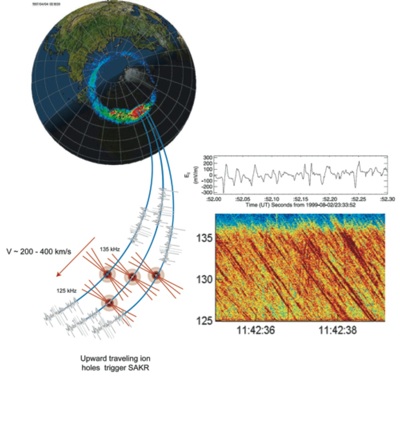 We
describe the statistical properties of narrowband drifting auroral
kilometric radiation ('striated'' AKR) based on observations from the
Cluster wideband receiver during 2002-2005. We show that the observed
characteristics, including frequency drift rate and direction, narrow
bandwidth, observed intensity, and beaming angular sizes are all
consistent with triggering by upward traveling ion solitary structures
(``ion holes''). We calculate the expected perturbation of a horseshoe
electron distribution function by an ion hole by integrating the
resonance condition for a cyclotron maser instability (CMI) using the
perturbed velocity distribution. We find that the CMI growth rate can
be strongly enhanced as the horseshoe velocity distribution contracts
inside the passing ion hole, resulting in a power gain increase greater
than 100 dB. The gain curve is sharply peaked just above the R-mode
cutoff frequency, with an effective bandwidth <=50 Hz,
consistent
with the observed bandwidth of striated AKR emission. Ion holes are
observed in situ in the acceleration region moving upward with spatial
scales and speeds consistent with the observed bandwidth and slopes of
SAKR bursts. Hence we suggest that SAKR bursts are a remote sensor of
ion holes and can be used to determine the frequency of occurrence,
locations in the acceleration region, and lifetimes of these structures. We
describe the statistical properties of narrowband drifting auroral
kilometric radiation ('striated'' AKR) based on observations from the
Cluster wideband receiver during 2002-2005. We show that the observed
characteristics, including frequency drift rate and direction, narrow
bandwidth, observed intensity, and beaming angular sizes are all
consistent with triggering by upward traveling ion solitary structures
(``ion holes''). We calculate the expected perturbation of a horseshoe
electron distribution function by an ion hole by integrating the
resonance condition for a cyclotron maser instability (CMI) using the
perturbed velocity distribution. We find that the CMI growth rate can
be strongly enhanced as the horseshoe velocity distribution contracts
inside the passing ion hole, resulting in a power gain increase greater
than 100 dB. The gain curve is sharply peaked just above the R-mode
cutoff frequency, with an effective bandwidth <=50 Hz,
consistent
with the observed bandwidth of striated AKR emission. Ion holes are
observed in situ in the acceleration region moving upward with spatial
scales and speeds consistent with the observed bandwidth and slopes of
SAKR bursts. Hence we suggest that SAKR bursts are a remote sensor of
ion holes and can be used to determine the frequency of occurrence,
locations in the acceleration region, and lifetimes of these structures.Publications Mutel, R. L.; Menietti, J. D.; Christopher, I. W.; Gurnett, D. A.; Cook, J. M. 2006, Striated auroral kilometric radiation emission: A remote tracer of ion solitary structures, Journal of Geophysical Research, Volume 111, Issue A10, CiteID A10203 Menietti, J. D.; Mutel, R. L.; Santolik, O.; Scudder, J. D.; Christopher, I. W.; Cook, J. M. 2006, Striated drifting auroral kilometric radiation bursts: Possible stimulation by upward traveling EMIC waves, Journal of Geophysical Research, Volume 111, Issue A4, CiteID A04214 |
Auroral Kilometric Radiation III: Growth Rates, the Shell Distribution, Perturbation by Solitary Waves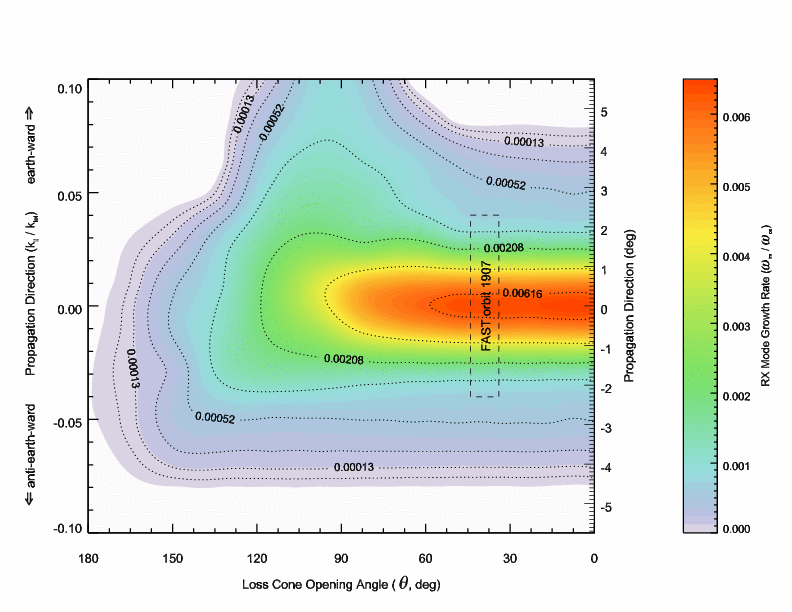 We
calculate growth rates and corresponding gains for RX and LO mode
radiation associated with the cyclotron maser instability for
parameterized horseshoe electron velocity distributions. The velocity
distribution function was modeled to closely fit the electron
distribution functions observed in the auroral cavity. We
systematically varied the model parameters as well as the propagation
direction to study the dependence of growth rates on model parameters.
The growth rate depends strongly on loss cone opening angle, which must
be less than 90 deg for significant CMI growth. The growth
rate is
sharply peaked for perpendicular radiation (kpar = 0), with a
full-width at half-maximum 1.7 deg, in good agreement with
observed k-vector orientations and numerical simulations. The
fractional bandwidth varied between 0.0001 and 0.01, depending most
strongly on propagation direction. This range encompasses nearly all
observed fractional AKR burst bandwidths. We find excellent agreement
between the computed RX mode emergent intensities and observed AKR
intensities assuming convective growth length Lc ~
20-40 km
and group speed 0.15c. The only computed LO mode growth rates
compatible observed LO mode radiation levels occurred for number
densities more than 100 times the average energetic electron densities
measured in auroral cavities. This implies that LO mode radiation is
not produced directly by the CMI mechanism but more likely results from
mode conversion of RX mode radiation. We find that perturbation of the
model velocity distribution by large ion solitary waves (ion holes) can
enhance the growth rate by a factor of 2-4. This will result in a gain
enhancement more than 40 dB depending on the convective growth length
within the structure. Similar enhancements may be
caused by
strong EMIC waves. We
calculate growth rates and corresponding gains for RX and LO mode
radiation associated with the cyclotron maser instability for
parameterized horseshoe electron velocity distributions. The velocity
distribution function was modeled to closely fit the electron
distribution functions observed in the auroral cavity. We
systematically varied the model parameters as well as the propagation
direction to study the dependence of growth rates on model parameters.
The growth rate depends strongly on loss cone opening angle, which must
be less than 90 deg for significant CMI growth. The growth
rate is
sharply peaked for perpendicular radiation (kpar = 0), with a
full-width at half-maximum 1.7 deg, in good agreement with
observed k-vector orientations and numerical simulations. The
fractional bandwidth varied between 0.0001 and 0.01, depending most
strongly on propagation direction. This range encompasses nearly all
observed fractional AKR burst bandwidths. We find excellent agreement
between the computed RX mode emergent intensities and observed AKR
intensities assuming convective growth length Lc ~
20-40 km
and group speed 0.15c. The only computed LO mode growth rates
compatible observed LO mode radiation levels occurred for number
densities more than 100 times the average energetic electron densities
measured in auroral cavities. This implies that LO mode radiation is
not produced directly by the CMI mechanism but more likely results from
mode conversion of RX mode radiation. We find that perturbation of the
model velocity distribution by large ion solitary waves (ion holes) can
enhance the growth rate by a factor of 2-4. This will result in a gain
enhancement more than 40 dB depending on the convective growth length
within the structure. Similar enhancements may be
caused by
strong EMIC waves.Publications Mutel, R. L.; Peterson, W. M.; Jaeger, T. R.; Scudder, J. D. 2007, Dependence of cyclotron maser instability growth rates on electron velocity distributions and perturbation by solitary waves, Journal of Geophysical Research, Volume 112, Issue A7, CiteID A07211 |
Auroral Kilometric Radiation IV: Determination of Angular Beaming Pattern Simultaneous
observations of AKR emission using the four-spacecraft Cluster array
were used to make the first direct measurements of the angular beaming
patterns of individual bursts. By comparing the spacecraft locations
and AKR burst locations, the angular beaming pattern was found to be
narrowly confined to a plane containing the magnetic field vector at
the source and tangent to a circle of constant latitude. Most rays
paths are confined within 15 deg of this tangent plane, consistent with
numerical simulations of AKR k-vector orientation at maximum growth
rate. The emission is also strongly directed upward in the tangent
plane, which we interpret as refraction of the rays as they leave the
auroral cavity. The narrow beaming pattern implies that an observer
located above the polar cap can detect AKR emission only from a small
fraction of the auroral oval at a given location. This has important
consequences for interpreting AKR visibility at a given location. It
also helps re-interpret previously published Cluster VLBI studies of
AKR source locations, which are now seen to be only a subset of all
possible source locations. Simultaneous
observations of AKR emission using the four-spacecraft Cluster array
were used to make the first direct measurements of the angular beaming
patterns of individual bursts. By comparing the spacecraft locations
and AKR burst locations, the angular beaming pattern was found to be
narrowly confined to a plane containing the magnetic field vector at
the source and tangent to a circle of constant latitude. Most rays
paths are confined within 15 deg of this tangent plane, consistent with
numerical simulations of AKR k-vector orientation at maximum growth
rate. The emission is also strongly directed upward in the tangent
plane, which we interpret as refraction of the rays as they leave the
auroral cavity. The narrow beaming pattern implies that an observer
located above the polar cap can detect AKR emission only from a small
fraction of the auroral oval at a given location. This has important
consequences for interpreting AKR visibility at a given location. It
also helps re-interpret previously published Cluster VLBI studies of
AKR source locations, which are now seen to be only a subset of all
possible source locations.Publications Mutel, R.L., Christopher, I. W., and Pickett, J. S., 2008, Cluster Multi-spacecraft determination of AKR angular beaming, submitted to Geophysics Research Letters, Jan 2008 |
Precession in BL Lac Radio Jet?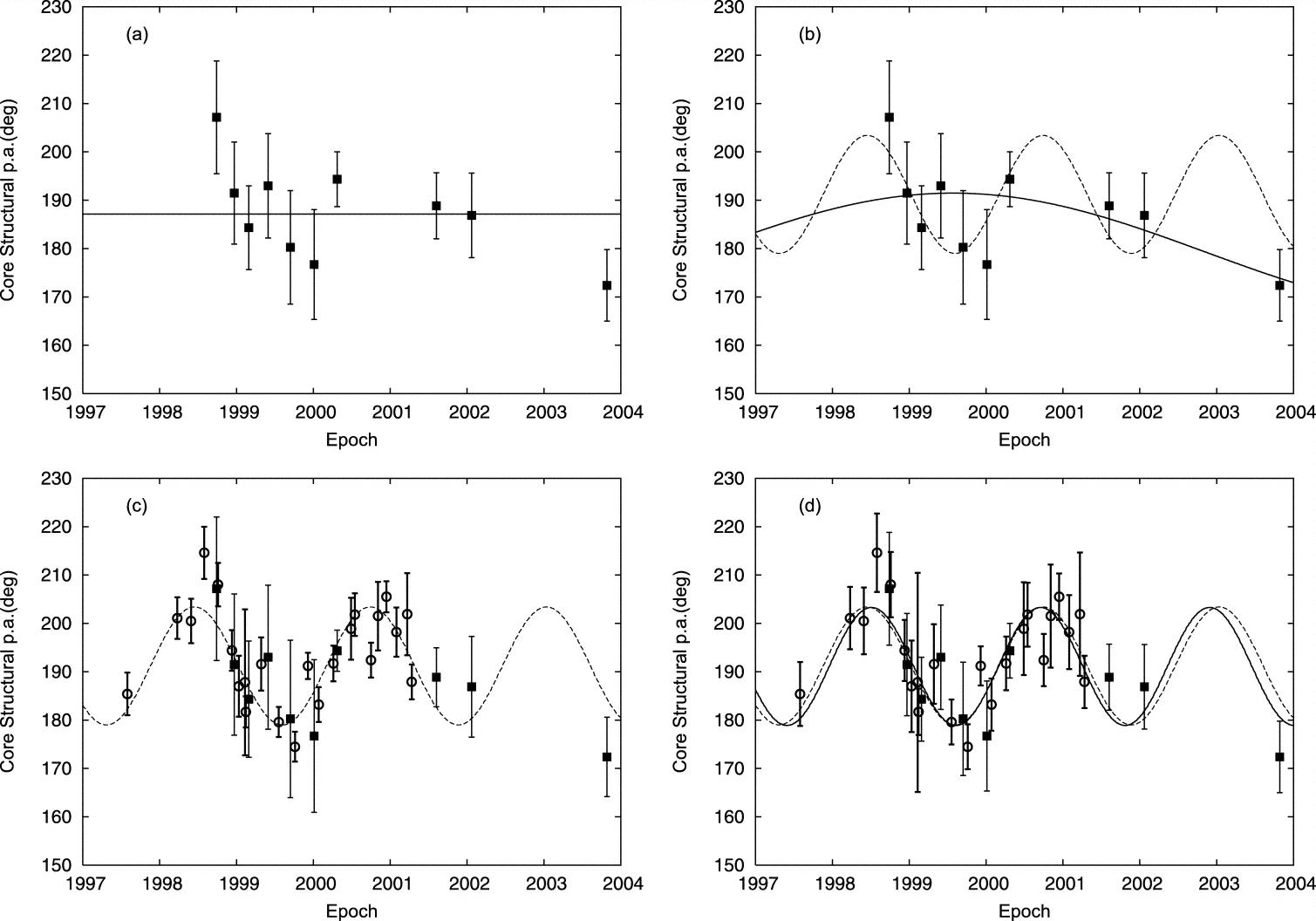 Stirling
et al. [2003] recently reported the discovery of a 2.3 yr periodic
variation in the structural position angle of the parsec-scale radio
core in the blazar BL Lac. We searched for independent confirmation of
this periodic behavior using 43 GHz images of the radio core during 10
epochs overlapping those of Stirling et al. Our maps are consistent
with several periodicities, including one near the period reported by
Stirling et al. By comparing our position angle measurements with those
of Stirling et al., we find strong, consistent evidence for position
angle variations of the inner core during the observed epochs. However,
the claim of periodic variation is not convincing, especially when the
most recent epochs (2000.60-2003.78) are included. A definitive
resolution will require continued monitoring of the core structure over
several periods. Stirling
et al. [2003] recently reported the discovery of a 2.3 yr periodic
variation in the structural position angle of the parsec-scale radio
core in the blazar BL Lac. We searched for independent confirmation of
this periodic behavior using 43 GHz images of the radio core during 10
epochs overlapping those of Stirling et al. Our maps are consistent
with several periodicities, including one near the period reported by
Stirling et al. By comparing our position angle measurements with those
of Stirling et al., we find strong, consistent evidence for position
angle variations of the inner core during the observed epochs. However,
the claim of periodic variation is not convincing, especially when the
most recent epochs (2000.60-2003.78) are included. A definitive
resolution will require continued monitoring of the core structure over
several periods.Publications Mutel, R. L. and Denn ,G. R. 2005, Is the Radio Core of BL Lacertae Precessing?, Astrophysical Journal, 623, 79-84. |
Magnetic Field Structures in the Radio Cores of Four Blazars: Rotation Measures and Detection of a Jet Boundary Layer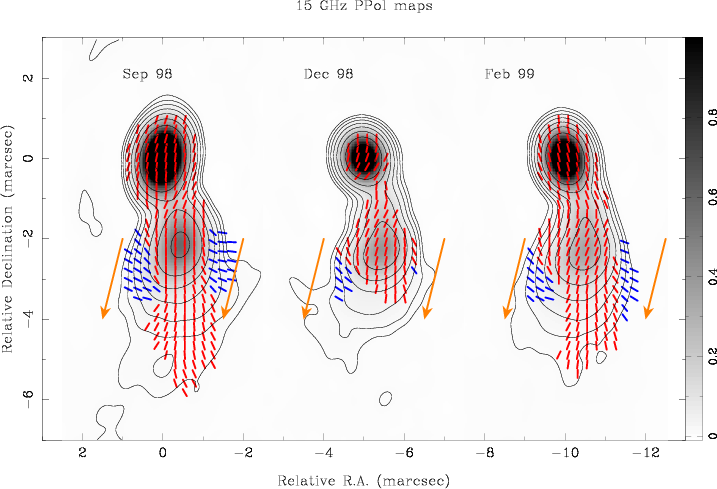 We
have monitored the morphology and magnetic field structure of the
parsec-scale radio jets of four blazars (1751+096, 1823+568, 2136+006,
2202+422) at nine epochs from 1998.7 - 2002.5 using the
VLBA. The jet components all have low rotation measure (RM)
and
nearly perpendicular magnetic field structure at all epochs, consistent
with transverse shocks and little foreground
thermal gas.
In contrast, the core has high variable RM, up to 8,200 rad-m-2 at some
epochs, but the true RM may be underestimated by blending from emerging
jet components. We also detected weak peripheral emission surrounding
the main jet at some epochs with nearly parallel magnetic field and
high fractional polarization. We suggest this may be a boundary layer
caused by interaction with the ambient medium. We
have monitored the morphology and magnetic field structure of the
parsec-scale radio jets of four blazars (1751+096, 1823+568, 2136+006,
2202+422) at nine epochs from 1998.7 - 2002.5 using the
VLBA. The jet components all have low rotation measure (RM)
and
nearly perpendicular magnetic field structure at all epochs, consistent
with transverse shocks and little foreground
thermal gas.
In contrast, the core has high variable RM, up to 8,200 rad-m-2 at some
epochs, but the true RM may be underestimated by blending from emerging
jet components. We also detected weak peripheral emission surrounding
the main jet at some epochs with nearly parallel magnetic field and
high fractional polarization. We suggest this may be a boundary layer
caused by interaction with the ambient medium. Publications Mutel, R., Denn, G., and Dreier, C. 2005, Magnetic Field Structure in the Radio Core of BL Lac: Variable Core Rotation and Detection of a Jet Boundary Layer,ASP Conference Proceedings, Vol. 340. Edited by J. Romney and M. Reid. San Francisco: Astronomical Society of the Pacific |
A Radio Cerenkov Search for ultra-high energy (UHE) Neutrinos (Ph.D. thesis of Ted Jaeger)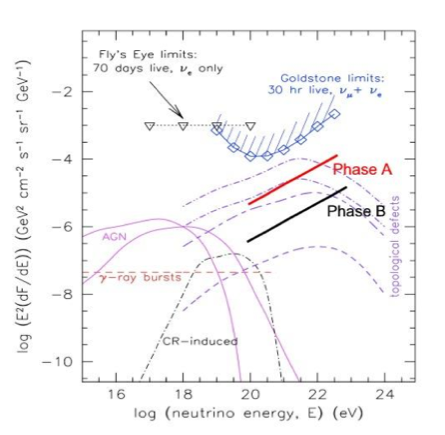 Determining
the origin and characteristics of extragalactic cosmic rays is of
fundamental importance in astrophysics. Direct detection of
high
energy cosmic rays from distant extragalactic sources is difficult due
to interaction with cosmic microwave background photons. The
cross section depends strongly on particle energy: For energies greater
than 10^19.5 electron volts, the so-called GZK limit [1], cosmic-ray
particles have a strong probability of pair production and pion
photo-production for propagation paths much greater than a few million
light years. Since most known extragalactic sources are at much greater
distances, direct direction of these cosmic rays is not
possible. However, a predicted consequence of such
interactions
is the production of ultra high energy (UHE) neutrinos, which travel
unimpeded in the intergalactic medium and hence may be
detectable. Any UHE neutrino flux should then be correlated
with
sources of the highest energy cosmic rays and may provide the only
method to evaluate UHE cosmic ray production models. In
addition,
some models of active galaxies and gamma-ray burst sources predict
copious production of UHE neutrinos directly. Currently no
UHE
neutrinos have ever been detected. Determining
the origin and characteristics of extragalactic cosmic rays is of
fundamental importance in astrophysics. Direct detection of
high
energy cosmic rays from distant extragalactic sources is difficult due
to interaction with cosmic microwave background photons. The
cross section depends strongly on particle energy: For energies greater
than 10^19.5 electron volts, the so-called GZK limit [1], cosmic-ray
particles have a strong probability of pair production and pion
photo-production for propagation paths much greater than a few million
light years. Since most known extragalactic sources are at much greater
distances, direct direction of these cosmic rays is not
possible. However, a predicted consequence of such
interactions
is the production of ultra high energy (UHE) neutrinos, which travel
unimpeded in the intergalactic medium and hence may be
detectable. Any UHE neutrino flux should then be correlated
with
sources of the highest energy cosmic rays and may provide the only
method to evaluate UHE cosmic ray production models. In
addition,
some models of active galaxies and gamma-ray burst sources predict
copious production of UHE neutrinos directly. Currently no
UHE
neutrinos have ever been detected. We
will search for Cerenkov radio bursts from UHE neutrino lunar impacts
using the Very Large Array, consisting of 27 large radio telescopes
operated by the National Radio Astronomy Observatory in New
Mexico. We will use sub-arrays pointed around the lunar limb.
This proposal pertains to Phase A of this effort, which consists of
using two sub-arrays of 4 antennas at an observing frequency of 1.4
GHz. The figure at right shows the relevant geometry - two pairs of
primary antenna beams of either side of the lunar limb
(central
blue disk). We
will search for Cerenkov radio bursts from UHE neutrino lunar impacts
using the Very Large Array, consisting of 27 large radio telescopes
operated by the National Radio Astronomy Observatory in New
Mexico. We will use sub-arrays pointed around the lunar limb.
This proposal pertains to Phase A of this effort, which consists of
using two sub-arrays of 4 antennas at an observing frequency of 1.4
GHz. The figure at right shows the relevant geometry - two pairs of
primary antenna beams of either side of the lunar limb
(central
blue disk). By observing a total of 50 hours (5x10 hour observing sessions centered at lunar transit), we will improve of the flux lower limit of the most sensitive upper limit (GLUE experiment) a factor of 10, and probe the flux-energy region predicted by topological defect models. Phase B, which will be proposed when all 27 EVLA antennas are available, will use 12 sub-arrays at 5 GHz, and will test neutrino production models for active galaxies and gamma-ray bursters, as well as the high-energy tail of the GZK interaction. Talks Jaeger, T. and Mutel, R. 2008, URSI Commission J talk, Boulder,CO |
Time-Lapse Imaging of Algol's Radio Magnetosphere (Ph. D. Thesis of Bill Peterson)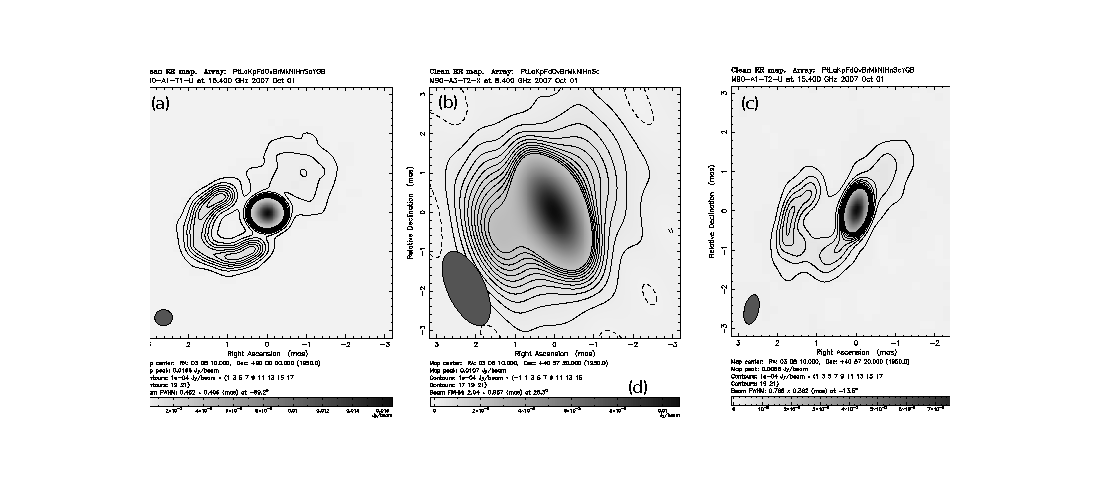 Determining
the spatial structure and physical processes in stellar magnetospheres
is a fundamental problem in stellar astrophysics. The research program
described in this proposal addresses two key questions that inform the
larger picture: (1) What is the structure and time-evolution of
extended stellar magnetospheres as mapped by their non-thermal radio
emission? (2) What plasma physical magnetospheric processes and
environments are responsible for the strong coherent, sometimes
periodic radio bursts detected in late-type dwarf magnetospheres? Determining
the spatial structure and physical processes in stellar magnetospheres
is a fundamental problem in stellar astrophysics. The research program
described in this proposal addresses two key questions that inform the
larger picture: (1) What is the structure and time-evolution of
extended stellar magnetospheres as mapped by their non-thermal radio
emission? (2) What plasma physical magnetospheric processes and
environments are responsible for the strong coherent, sometimes
periodic radio bursts detected in late-type dwarf magnetospheres? To address these questions, multi-epoch observations of several radio-luminous, nearby late-type stars will be made using the High Sensitivity Array (HSA), the world’s most powerful radio imaging VLBI array. Radio magnetospheric images made with the HSA will have 3-5 times the brightness sensitivity and twice the angular resolution of any previous radio images of stellar magnetospheres. This will allow the first detailed imaging of magnetospheric structure, including possible large-scale loops analogous to solar CME events. The HSA images will also provide a critical test of the polar model, derived from x-ray and optical studies, in which magnetic flux is concentrated near the poles. Rather than survey a large number of stars, we will target a few relatively nearby active binaries for detailed multi-epoch study, observing over a complete orbital period when possible. We will coordinate with M. Güdel (ETH Zurich) to schedule coeval HSA - x-ray observations on Chandra, XMM-Newton, and other x-ray telescopes. The joint x-ray radio studies will allow modeling of the overall spatial distribution of thermal and non-thermal plasma and energy release in radio - x-ray flares with unprecedented sensitivity and angular resolution. |